Located just a few kilometres east of the graceful town of Amalfi, Ravello boasts a rich history dating back to the 5th century. Initially established as a refuge against Barbarian invasions following the fall of the Roman Empire, Ravello later flourished as a key port in the Maritime Republic of Amalfi during the 9th century. The inhabitants were involved in maritime trade with the Orient, and that gave Ravello both wealth and status. The prosperity of this era manifested in the construction of grand castles, villas, churches, and civic buildings that showcased their affluence.
Today, perched in the hills overlooking the Amalfi coast, Ravello is home to many famous buildings like Villa Cimbrone, Villa Rufolo, and the architecturally striking Oscar Niemeyer Auditorium. What makes Ravello known to the outside is the Ravello Festival and its concert society, which gives Ravello the name “The City of the Music”.
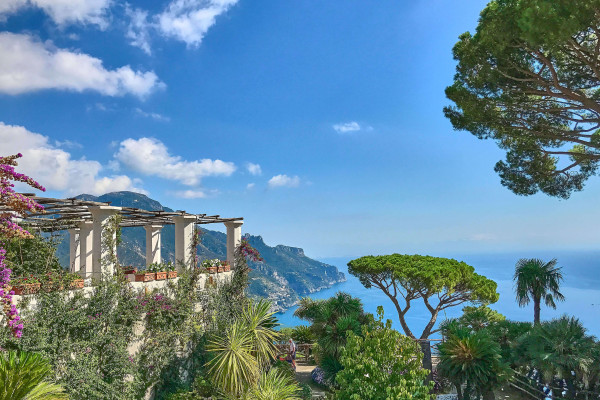
A while back, a photo of Ravello’s picturesque landscape on the Amalfi Coast caught my eye. The enchanting mountaintop setting and the remarkable coastal scenery etched themselves into my memory. Fast forward to our family’s 7-day sojourn along the Amalfi Coast, and I finally had the opportunity to explore Ravello. Allocating a dedicated day to Ravello, we eagerly anticipated the highlights of our visit:
- Admiring the Coastal Splendor of Oscar Niemeyer Auditorium
- Taking in the Unique Amalfi Coastal Vistas from Villa Rufolo
- Enjoying a Lunch at the Garden Restaurant
- Observing the Bustle of Crowds in Piazza Duomo
- Exploring Ravello’s Hidden Neighborhoods
Admiring the Coastal Splendor of Oscar Niemeyer Auditorium
We followed the parking sign and parked our car inside a building. The parking place was spacious and not even full on that day.
Stepping out of the parking lot, the joyful coastline view lay just in front of us. The sea was calm, and soft clouds leisurely drifted across the blue sky.
Below us, Minori, the uncrowded seaside town, had terraced gardens climbing the rugged hillsides, along with a pleasant seafront featuring a wide cove.
Adjacent to the pedestrian walkway, we saw this enormous building, the Oscar Niemeyer Auditorium, designed and named after the Brazilian architect Oscar Niemeyer. The architecture of the building presents a seamless curved line resembling a sleeping beauty. Today, the “Oscar Niemeyer” Auditorium serves as the setting for the Ravello Festival.
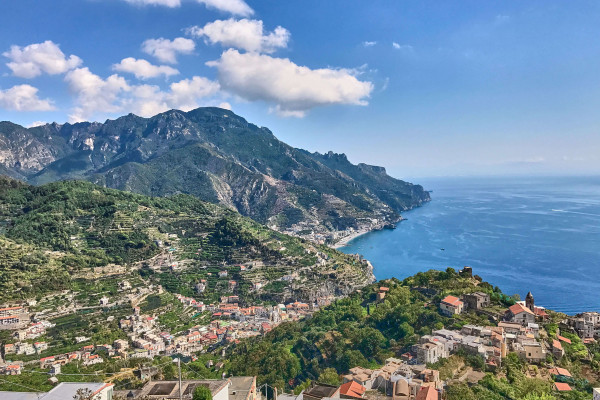
Taking in the Unique Amalfi Coastal Vistas from Villa Rufolo
Following Via della Repubblica and passing through a tunnel, where most buses and taxis halted, the elegant and magnificent Villa Rufolo emerged behind the tunnel on the left side. To explore Villa Rufolo, you can either participate in a Ravello private walking tour or purchase tickets on-site..
The key attractions of Villa Rufolo include the Entrance Tower, the Main Tower, the terraces, the Moorish-style cloister surrounded by columns, and the most breathtaking view of the Amalfi Coast. As I strolled through the gardens, I found myself unable to resist capturing numerous pictures, including one that had etched itself into my memory..
Numerous quiet corners with benches offered a relaxing atmosphere. The upper terrace gardens contained cypress trees, yuccas, and palms. I could easily envision how this place had inspired the German composer Richard Wagner to compose the second act of his final opera, Parsifal. Since 1952, the Ravello Music Festival, an open-air concert honoring Wagner, has been held in Villa Rufolo every summer.
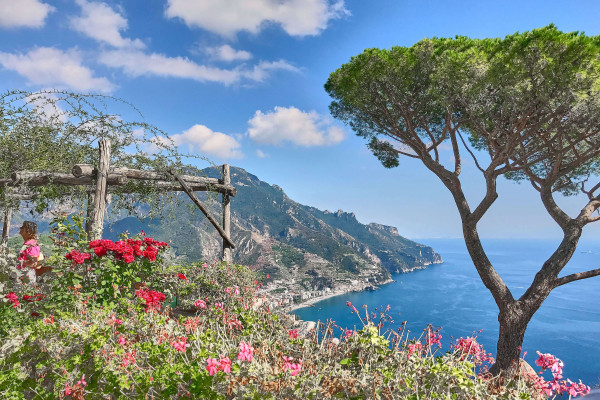
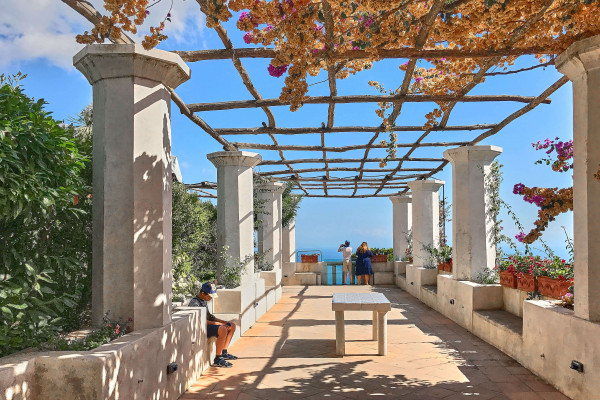
Enjoying a Lunch at the Garden Restaurant
After spending several hours in the Villa Rufolo, our stomachs began to growl. Exiting Villa Rufolo, we found ourselves in the main square of Ravello, where almost every restaurant was full.
Opting to head back towards the tunnel, we settled on dining at the Garden Restaurant affiliated with a hotel. This establishment, more of a bar than a traditional restaurant, offered simple fare complemented by an extensive selection of beverages.
While the food might not have been budget-friendly, the panoramic view of the coast was truly impressive. Ravello felt like a natural balcony, perched above the Amalfi coast. As I sipped a glass of wine and enjoyed a plate of salad, I could feel the relaxation setting in, all against the backdrop of the serene, silk-blue sea.
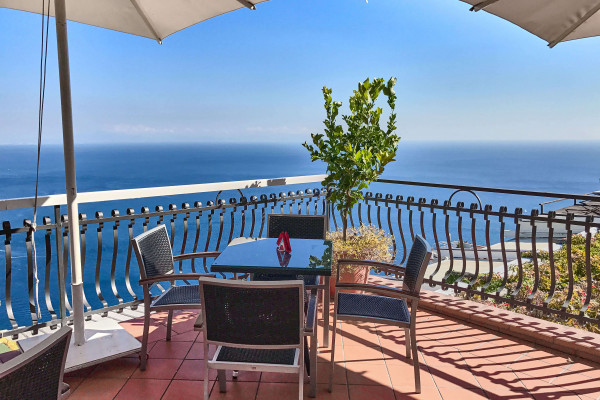
Observing the Bustle of Crowds in Piazza Duomo
As in many European towns, the spiritual and social center of Ravello revolve around its Duomo, the Cathedral of Ravello. Established in 1086, the Rufolo family played a pivotal role in supporting the church’s construction. This Arabic-inspired sanctuary seamlessly blended Baroque and Romanesque styles, with a bell tower reflecting Moorish and Byzantine influences.
While the exterior may not immediately strike as extraordinary, a closer inspection reveals numerous distinctive features. Six spiraled columns, supported by marble lions, uphold the central nave, all made from sculpted white marble.
Another attraction is the two-room museum, accessible via a side entrance on Via Richard Wagner. The collection of the museum features marble busts and slabs decorated with mosaics.
The square in front of the cathedral buzzes with restaurants and shops showcasing local products. One snack bar, named “Klingsor” in homage to Richard Wagner, caught our attention. Despite the charm of the square, we decided to venture into the quieter streets of Ravello’s neighbourhood after a brief stay.
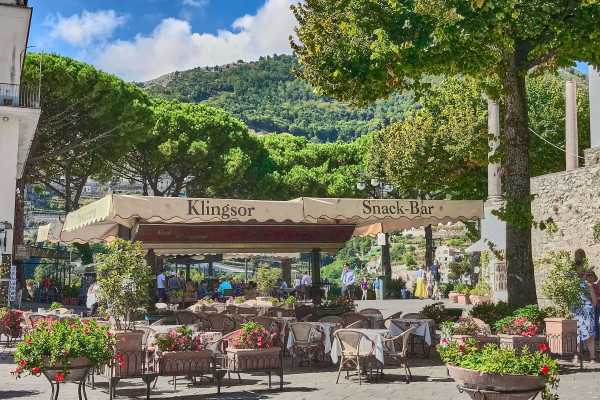
Exploring Ravello’s Hidden Neighborhoods
Following Via S. Francesco behind Hotel Rufolo, we walked to the backstreets of Ravello. As we passed under an arched walkway, a charming church (Chiesa S.Francesco dei Frati Minori Conventuali) caught our attention on the right.
Winding through the narrow street, exclusively reserved for pedestrians, we discovered more restaurants, bars, and hotels lining the way. Cats lounged lazily on the ground, atop walls, and in quiet corners, seemingly outnumbering the discernible tourists..
Our journey led us to Via Santa Chiara, a picturesque pedestrian path offering panoramic views and guiding us to another renowned site, Villa Cimbrone. Along the way, we saw a farm cultivating organic produce. To my surprise, I spotted Loofah, a vegetable reminiscent of my childhood. I recalled my grandfather cultivating Loofah on our rooftop balcony, where it would grow long vines, forming a natural sunshade. Once ripened, the vegetable’s fibrous texture resembled a scrubbing sponge, often used for bathroom cleaning.
A sign indicating “1500 steps to Atrani” attracted us, but as it wasn’t part of our planned itinerary, we turned back, following Via Santissma Trinita. This street had several hotels, and we noticed the unique feature of some streets having two parts: one with a flat slope and the other with stairs. The flat section served as a passage for narrow carts used by local hotels to transport goods and luggage.
Via Santissma Trinita intersected with Via S. Francesco and Via Dei Rufolo, guiding us back to the central square.
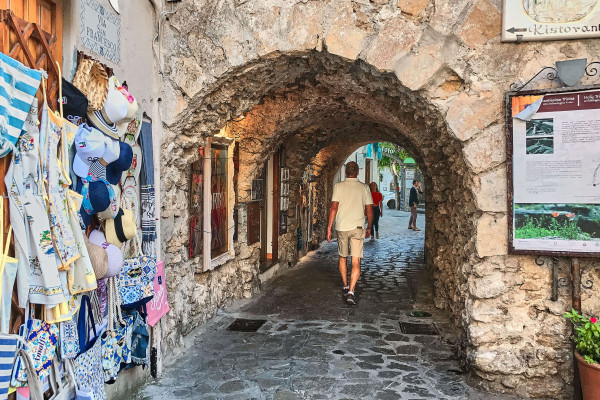
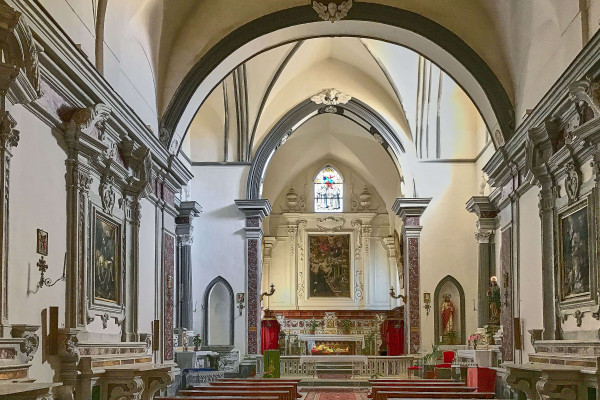
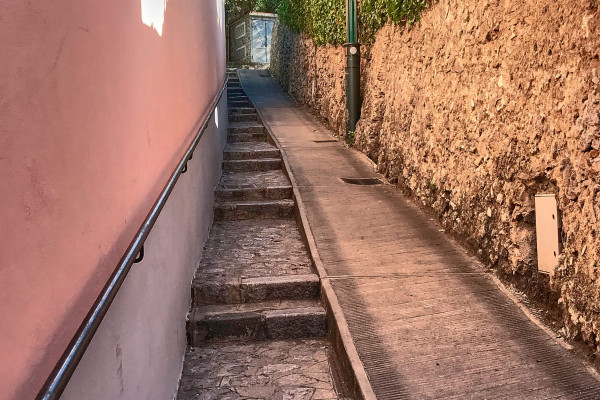
Travel tips
Where to stay
Other than Amalfi or Salerno, Ravello proves to be an ideal hub for exploring the Amalfi Coast. All hotels are conveniently situated within walking distance from the centre.
How to get there
- Hop on the SITA buses from Salerno, Positano, or Sorrento, and disembark at Amalfi. Then, switch to another SITA bus to reach Ravello. Alternatively, take a leisurely walk up the hill to Ravello.
- Navigate the main highways in this region, including SS145, SS163, and SS373. If coming from Atrani, follow Via Castiglione to reach Ravello.
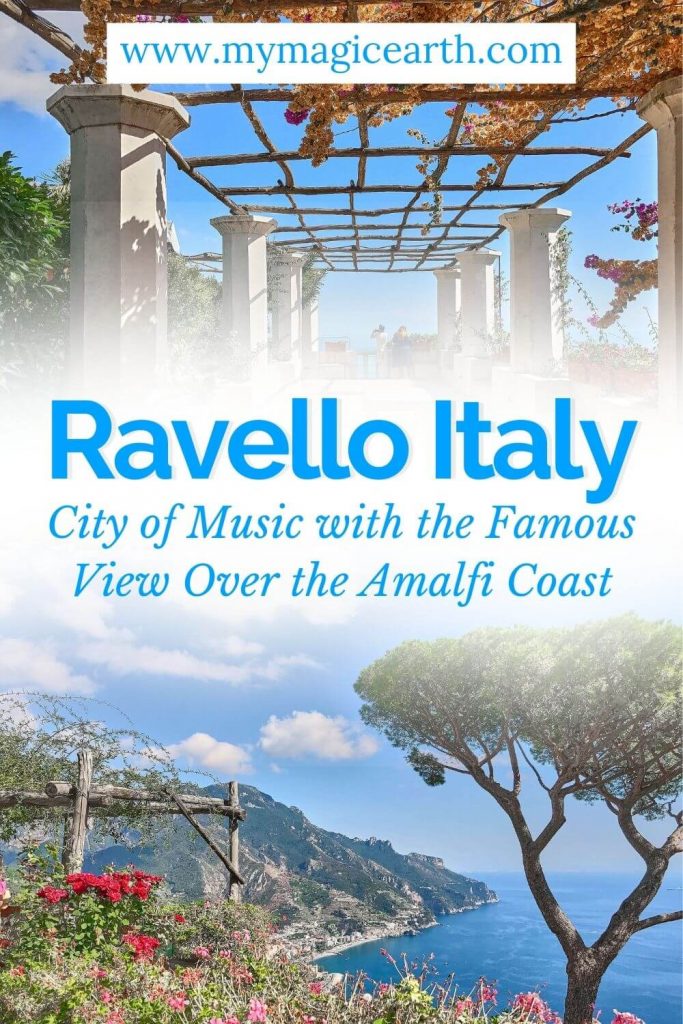

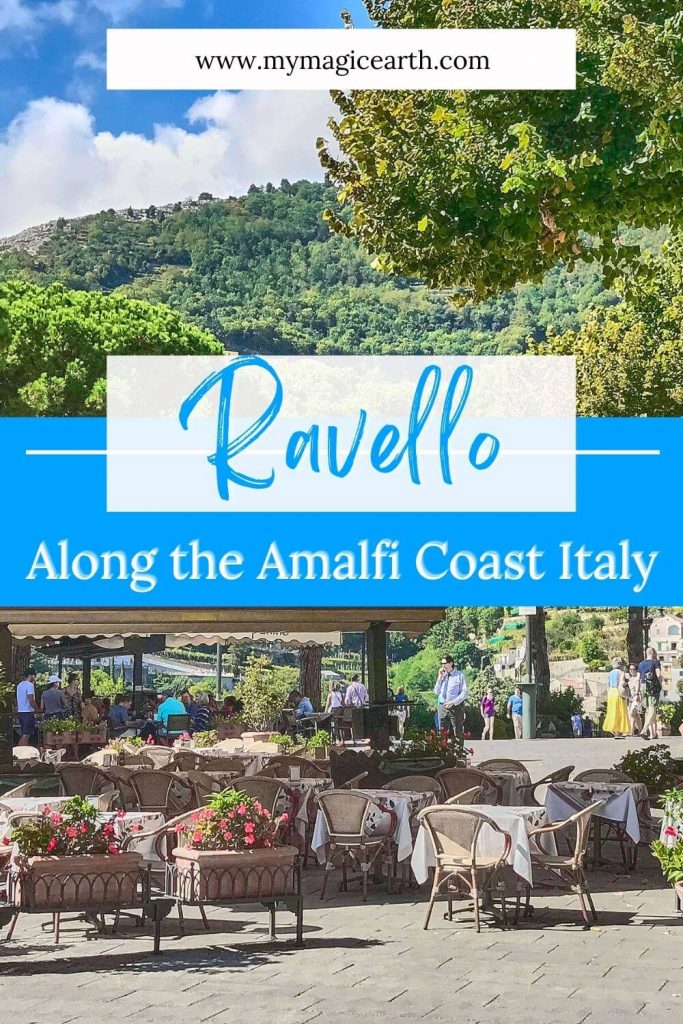

Thanks for the tip on joining a tour and how to get there. It’s very helpful. The view of the Hotel Villa Cimbrone is nice for garden weddings. I’d love to dine as well at the garden restaurant or bar as you say, haha!
I have heard of Amalfi and admire pictures from there but had no idea about Ravello, city of music. The views of breathtaking and there are so many beautiful things to do and capture. Hikes look so much fun. The view of Minori is lovely. The hotels look so inviting and it would be a dream to see a musical concert there. Thanks for sharing.
All I can say is, everything about Ravello is beautiful! Reading your blog is like walking with you exploring the town. Your pictures are beautiful, too! Blue sky, blue sea, gorgeous architecture, I definitely want to visit Ravello, the City of Music.
Wow, what impressive views. I haven’ been to the Amalfi Coast yet, but hope to one day. We’d probably do both hikes. Those hotels are so palacial!
I love Italy. Italian architecture, small narrow streets, wine, and food. But I haven’t been to Ravello yet. It’s on my list. And after your article and amazing photos, I would like to be there immediately. I would love to visit Oscar Niemeyer Auditorium and listen to one of the concerts in this city of music.
We loved Ravello, how lovely to read your post and above all enjoy your photographs to take me back. I hadn’t read up on its history when we went, so it’s interesting to learn that it was so important during the 9th Century. And I’m with you on the views, they truly are breathtaking. Walking around the town is such a pleasure, though it can get so crowded.
I was so excited to see this blog post. It has been a long time since we visited Ravello. So good to see it through your eyes. The views out over the Amalfi Coast truly are stunning. Each spot is just a little bit different. We loved walking around the small town. And resisted the urge to go home with a bag of pottery souvenirs. We did not hike down to Atrani. But did visit on a road trip. We also missed the hike up the Path of the Gods. A good reason to head back. Thanks for taking me back.
I have only done a few hours on the Amalfi coast and just drove the main coastal road around the peninsula. Dam, I have missed out on a lot of beauty but lucky I am going back here very soon so I will sure stop off a few places for a couple of days. Defo will stop off at Ravello, it’s so pretty! I love the views.
It looks like a gorgeous place to go – and those views are spectacular! I love going places where there are so many kitties, but I also wish they’d do something to help control the population (spay/neuter). I definitely would want to hike in that area someday!